一堂英语读写课的教学设计
- 格式:doc
- 大小:15.50 KB
- 文档页数:2
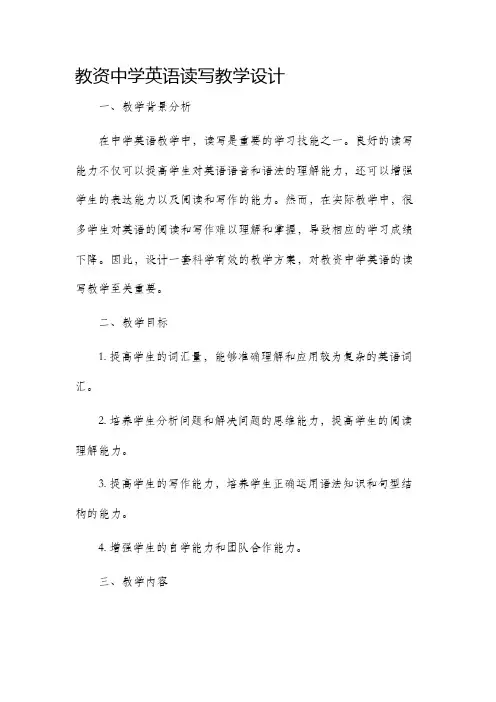
教资中学英语读写教学设计一、教学背景分析在中学英语教学中,读写是重要的学习技能之一。
良好的读写能力不仅可以提高学生对英语语音和语法的理解能力,还可以增强学生的表达能力以及阅读和写作的能力。
然而,在实际教学中,很多学生对英语的阅读和写作难以理解和掌握,导致相应的学习成绩下降。
因此,设计一套科学有效的教学方案,对教资中学英语的读写教学至关重要。
二、教学目标1. 提高学生的词汇量,能够准确理解和应用较为复杂的英语词汇。
2. 培养学生分析问题和解决问题的思维能力,提高学生的阅读理解能力。
3. 提高学生的写作能力,培养学生正确运用语法知识和句型结构的能力。
4. 增强学生的自学能力和团队合作能力。
三、教学内容1. 阅读教学:通过选择适当的英文阅读材料,培养学生对英语文章的阅读兴趣,并提高阅读能力。
教师可以从课内外资源中选取包括故事、新闻、诗歌等各类阅读材料,将其难度适应到学生的水平,激发学生对阅读的兴趣。
在阅读中,教师可以引导学生掌握阅读技巧,如快速浏览、理解关键信息、推断词义等,帮助学生提高阅读效率。
2. 写作教学:针对学生的写作能力,教师可以从日常生活中的话题出发,引导学生进行写作训练。
例如,教师可以提供一些简单的写作任务,如写一篇关于自己家庭的短文、描述自己最喜欢的一本书等,通过写作训练,提高学生的语言表达和写作能力。
教师可以对学生的作品进行评议和修改,帮助学生提高写作技巧。
3. 词汇教学:在教学中,教师可以将词汇教学与阅读教学和写作教学有机结合,通过课前预习、课内拓展和课后巩固等方式,帮助学生记忆和运用英语词汇。
教师可以通过单词卡片、词汇表和词汇游戏等形式,提高学生对词汇的记忆和理解。
四、教学方法1. 任务型教学法:通过设置任务和解决问题的方式来引导学生自主学习。
教师可以设定一些任务,如让学生合作完成一篇阅读理解,或是让学生通过讨论和辩论提高写作能力。
通过任务的设置,能够提高学生的学习动力和积极性。
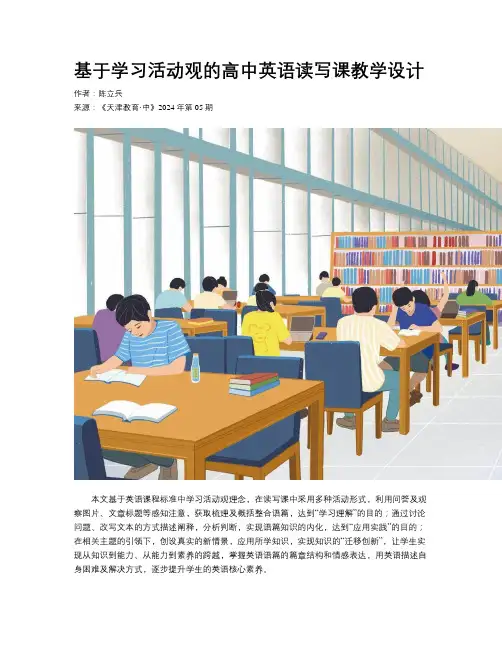
基于学习活动观的高中英语读写课教学设计作者:陈立兵来源:《天津教育·中》2024年第05期本文基于英语课程标准中学习活动观理念,在读写课中采用多种活动形式,利用问答及观察图片、文章标题等感知注意,获取梳理及概括整合语篇,达到“学习理解”的目的;通过讨论问题、改写文本的方式描述阐释,分析判断,实现语篇知识的内化,达到“应用实践”的目的;在相关主题的引领下,创设真实的新情景,应用所学知识,实现知识的“迁移创新”,让学生实现从知识到能力、从能力到素养的跨越,掌握英语语篇的篇章结构和情感表达,用英语描述自身困难及解决方式,逐步提升学生的英语核心素养。
一、研究背景及意义读写课是高中英语教学的重要课型,学生在教师的帮助下对文本内容、结构及人物情感通过问题或讨论的方式进行梳理,对文本进行更深层次的理解。
阅读是吸收,写作是倾吐,学生通过阅读吸收文本知识,培养篇章意识,分析共情人物情感,然后将其运用到实际写作中,提升用英语做事的能力,两者相互促进、相互提升,最终达到语言、文化、思维三者紧密结合的目的。
但是现在部分教师过度关注文本信息,文本解读碎片化,缺乏深度,教学中忽略对学生输出的支架指导;学生太重词汇和语法,轻篇章结构,认为英语素养全靠背诵,忽略了语言背后的思想、观点和态度;割裂了语言与文化、语言与思维的关系,忽略了英语学习环境的重要性,缺乏在情景中学习英语的机会,导致学生无法进行迁移创新,综合核心素养得不到很好的提高;写作也常常与阅读脱节,难以达到以读促写的目的。
本文以高中英语读写课为例,探究在英语学习活动观中学生如何在教师的指引下理解文本,使学生明白阅读是了解知识、了解他人的感悟;阅读是体会文本中人物对生活、人生或事物的看法,学生可能产生共鸣抑或不认同,这种情感的参与无形中锻炼了学生的批判性思维;阅读是写作的起点,学生通过阅读模仿英语语言、发展行为逻辑等,而写作是阅读的延伸、是语言的运用,情感的表达也是与他人和社会沟通,从而最终形成个人观点,让思维具有创造性。
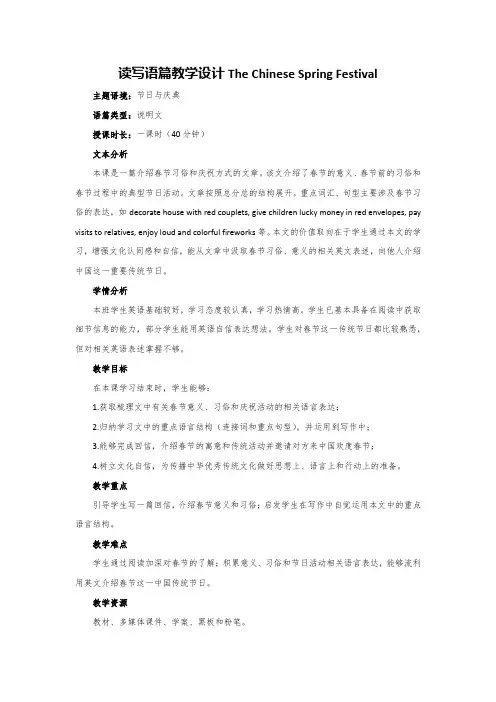
读写语篇教学设计The Chinese Spring Festival 主题语境:节日与庆典语篇类型:说明文授课时长:一课时(40分钟)文本分析本课是一篇介绍春节习俗和庆祝方式的文章。
该文介绍了春节的意义、春节前的习俗和春节过程中的典型节日活动。
文章按照总分总的结构展开。
重点词汇、句型主要涉及春节习俗的表达,如decorate house with red couplets, give children lucky money in red envelopes, pay visits to relatives, enjoy loud and colorful fireworks等。
本文的价值取向在于学生通过本文的学习,增强文化认同感和自信,能从文章中汲取春节习俗、意义的相关英文表述,向他人介绍中国这一重要传统节日。
学情分析本班学生英语基础较好,学习态度较认真,学习热情高。
学生已基本具备在阅读中获取细节信息的能力,部分学生能用英语自信表达想法。
学生对春节这一传统节日都比较熟悉,但对相关英语表述掌握不够。
教学目标在本课学习结束时,学生能够:1.获取梳理文中有关春节意义、习俗和庆祝活动的相关语言表达;2.归纳学习文中的重点语言结构(连接词和重点句型),并运用到写作中;3.能够完成回信,介绍春节的寓意和传统活动并邀请对方来中国欢度春节;4.树立文化自信,为传播中华优秀传统文化做好思想上、语言上和行动上的准备。
教学重点引导学生写一篇回信,介绍春节意义和习俗;启发学生在写作中自觉运用本文中的重点语言结构。
教学难点学生通过阅读加深对春节的了解;积累意义、习俗和节日活动相关语言表达,能够流利用英文介绍春节这一中国传统节日。
教学资源教材、多媒体课件、学案、黑板和粉笔。
教学过程Step 1 Lead in1.T plays a short video about the Spring Festival2.T shows an assignment: Suppose you are Lihua, your American friend Mike want to know more about the Spring Festival. You need to write a letter of reply including the following points: the meaning of the Spring Festival, the activities and inviting him to China to experience the festival.设计意图:利用视频引出主题,激活学生背景知识。
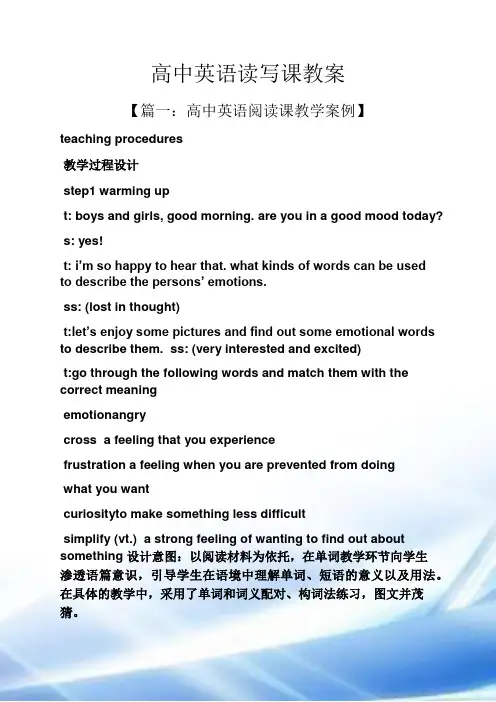
高中英语读写课教案【篇一:高中英语阅读课教学案例】teaching procedures教学过程设计step1 warming upt: boys and girls, good morning. are you in a good mood today? s: yes!t: i’m so happy to hear that. what kinds of words can be usedto describe the persons’ emotions.ss: (lost in thought)t:let’s enjoy some pictures and find out some emotional words to describe them. ss: (very interested and excited)t:go through the following words and match them with the correct meaningemotionangrycross a feeling that you experiencefrustration a feeling when you are prevented from doingwhat you wantcuriosityto make something less difficultsimplify (vt.) a strong feeling of wanting to find out about something 设计意图:以阅读材料为依托,在单词教学环节向学生渗透语篇意识,引导学生在语境中理解单词、短语的意义以及用法。
在具体的教学中,采用了单词和词义配对、构词法练习,图文并茂猜。
t: would you like to think of some emotional words which can fit the situation. situation 1:this morning when i got to school, my headmaster asked me to her office. she told me i was the only student who had passed the exam and would have a chance to be an exchange student.s1: happiness/excitementsituation 2:however, about half an hour later, i was called to the office again and was told that the teacher had made a mistake!s2:disappointment/frustrationt:where can we find happiness in our life? are they really happy? (more pictures for the students to glance through)ss: (heated discussion)t: i can’t agree more. such pictures do bring us so much simple happiness. to have happiness is just so easy.设计意图:从学生的实际出发引导、激发学生的学习兴趣和探究热情,引起学生情感上的共鸣,并自然地导入下一个活动任务。
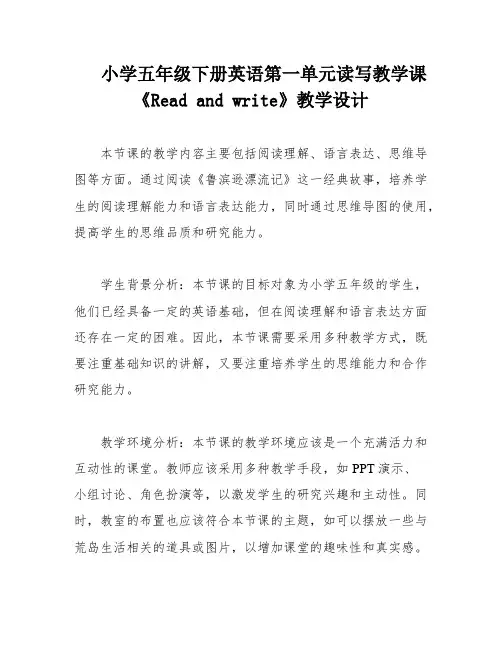
小学五年级下册英语第一单元读写教学课《Read and write》教学设计本节课的教学内容主要包括阅读理解、语言表达、思维导图等方面。
通过阅读《鲁滨逊漂流记》这一经典故事,培养学生的阅读理解能力和语言表达能力,同时通过思维导图的使用,提高学生的思维品质和研究能力。
学生背景分析:本节课的目标对象为小学五年级的学生,他们已经具备一定的英语基础,但在阅读理解和语言表达方面还存在一定的困难。
因此,本节课需要采用多种教学方式,既要注重基础知识的讲解,又要注重培养学生的思维能力和合作研究能力。
教学环境分析:本节课的教学环境应该是一个充满活力和互动性的课堂。
教师应该采用多种教学手段,如PPT演示、小组讨论、角色扮演等,以激发学生的研究兴趣和主动性。
同时,教室的布置也应该符合本节课的主题,如可以摆放一些与荒岛生活相关的道具或图片,以增加课堂的趣味性和真实感。
3.教学目标和教学重点难点教学目标:通过本节课的研究,学生应该能够快速理解语篇,根据思维导图进行复述或角色表演,培养学生的阅读理解能力和语言表达能力;同时,学生应该能够按意群朗读,根据关键词提取信息,提高学生的研究能力和思维品质;最后,通过小组比赛和互评相结合的评价方式,激发学生的研究兴趣和主动性。
教学重点:本节课的教学重点是培养学生的阅读理解能力和语言表达能力。
教师应该注重对学生的阅读策略和思维导图的讲解,帮助学生快速理解语篇,同时,通过角色扮演和个性化书写等方式,提高学生的语言表达能力。
教学难点:本节课的教学难点在于如何提高学生的思维品质和研究能力。
教师应该采用多种教学手段,如小组讨论、互动游戏等,激发学生的思维能力和合作研究能力。
同时,教师还应该注重对学生的研究态度和研究方法的引导,帮助学生形成良好的研究惯和自主研究能力。
巩固了学生对于日常活动的词汇掌握。
2.图片展示,询问学生对于生活在岛上的人会有哪些困难和挑战,引导学生思考。
设计意图:通过图片展示,激发学生的想象力,引导学生思考XXX在孤岛上的生活,为后续的阅读做好铺垫。
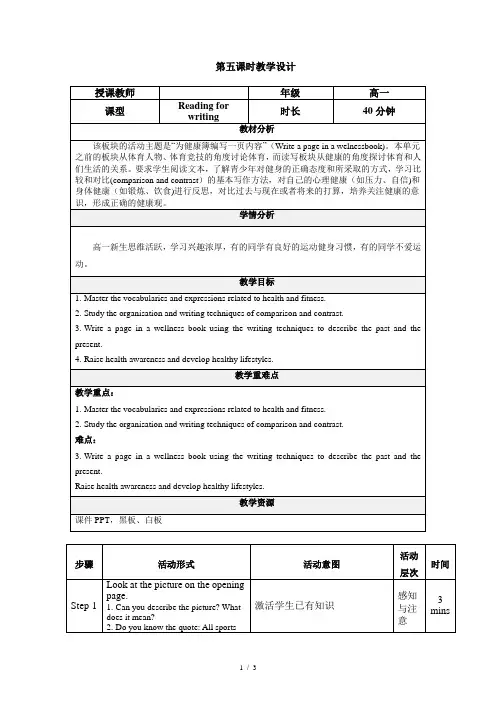
第五课时教学设计for all people?Step 2Pre-reading1.Observe the pictures and findout what changes they have.2.How can we keep healthy?3.Do you know what a wellnessbook is?引导学生观察健身运动带来的变化,表达保持身体健康的方法,了解健康书。
获取与梳理5minsStep 3 While-reading1.Read what Kayla wrote and match.2.Read what Kayla wrote and answerthe questions:●What problem did Kayla have inthe past?●What does the sentence “I almostwent bananas” mean?●What makes her change herthinking?plete the outline with the wordsand phrases from the text.4.Underline the words that showsimilarities and differences.通过阅读Kayla的文章,梳理总结Kayla健身前后的变化,以及这些变化带来的结果。
熟悉比较、对比类文本的结构,并整理出文本中表达对比的语言。
描述与阐释获取与梳理分析与判断3minsStep 4 Writing:Write a page for a class wellnessbook1.Discuss the questions.e the outline to organise yourideas.3.Write the first draft.4.Swap the draft and correct it●讨论课本活动3的活动,收集写作素材。
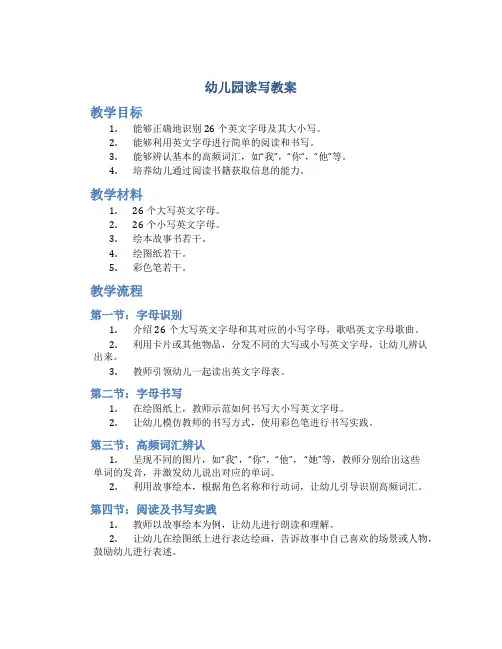
幼儿园读写教案
教学目标
1.能够正确地识别26个英文字母及其大小写。
2.能够利用英文字母进行简单的阅读和书写。
3.能够辨认基本的高频词汇,如“我”,“你”,“他”等。
4.培养幼儿通过阅读书籍获取信息的能力。
教学材料
1.26个大写英文字母。
2.26个小写英文字母。
3.绘本故事书若干。
4.绘图纸若干。
5.彩色笔若干。
教学流程
第一节:字母识别
1.介绍26个大写英文字母和其对应的小写字母,歌唱英文字母歌曲。
2.利用卡片或其他物品,分发不同的大写或小写英文字母,让幼儿辨认出来。
3.教师引领幼儿一起读出英文字母表。
第二节:字母书写
1.在绘图纸上,教师示范如何书写大小写英文字母。
2.让幼儿模仿教师的书写方式,使用彩色笔进行书写实践。
第三节:高频词汇辨认
1.呈现不同的图片,如“我”,“你”,“他”,“她”等,教师分别给出这些
单词的发音,并激发幼儿说出对应的单词。
2.利用故事绘本,根据角色名称和行动词,让幼儿引导识别高频词汇。
第四节:阅读及书写实践
1.教师以故事绘本为例,让幼儿进行朗读和理解。
2.让幼儿在绘图纸上进行表达绘画,告诉故事中自己喜欢的场景或人物,鼓励幼儿进行表述。
教学评估
1.对于幼儿的字母识别能力进行单独测试,给出反馈并进行矫正。
2.观察幼儿的书写实践,进行评估,给予针对性的指导。
3.听取幼儿对于故事的表述和画图的意见,进行评估。
根据幼儿表现评估教学成果。
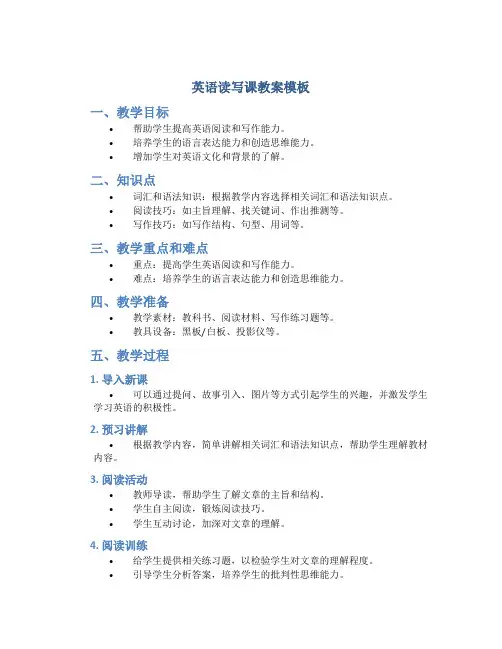
英语读写课教案模板一、教学目标•帮助学生提高英语阅读和写作能力。
•培养学生的语言表达能力和创造思维能力。
•增加学生对英语文化和背景的了解。
二、知识点•词汇和语法知识:根据教学内容选择相关词汇和语法知识点。
•阅读技巧:如主旨理解、找关键词、作出推测等。
•写作技巧:如写作结构、句型、用词等。
三、教学重点和难点•重点:提高学生英语阅读和写作能力。
•难点:培养学生的语言表达能力和创造思维能力。
四、教学准备•教学素材:教科书、阅读材料、写作练习题等。
•教具设备:黑板/白板、投影仪等。
五、教学过程1. 导入新课•可以通过提问、故事引入、图片等方式引起学生的兴趣,并激发学生学习英语的积极性。
2. 预习讲解•根据教学内容,简单讲解相关词汇和语法知识点,帮助学生理解教材内容。
3. 阅读活动•教师导读,帮助学生了解文章的主旨和结构。
•学生自主阅读,锻炼阅读技巧。
•学生互动讨论,加深对文章的理解。
4. 阅读训练•给学生提供相关练习题,以检验学生对文章的理解程度。
•引导学生分析答案,培养学生的批判性思维能力。
5. 写作指导•根据教学内容,讲解相关写作技巧,如写作结构、句型、用词等。
•给学生提供写作练习题,引导学生动手写作。
•学生相互交流,互相改进作文,提高写作质量。
6. 作业布置•布置相关阅读和写作作业,巩固学生的学习成果。
六、教学反思•教师根据教学情况,总结教学过程中出现的问题,对教学策略进行调整和改进。
以上是一个英语读写课教案模板,根据具体情况,可以适当调整教学内容和教学活动的顺序,以及增删教学准备和教学资源。
通过这个模板,可以帮助教师规范化教学过程,提高课堂教学效果。
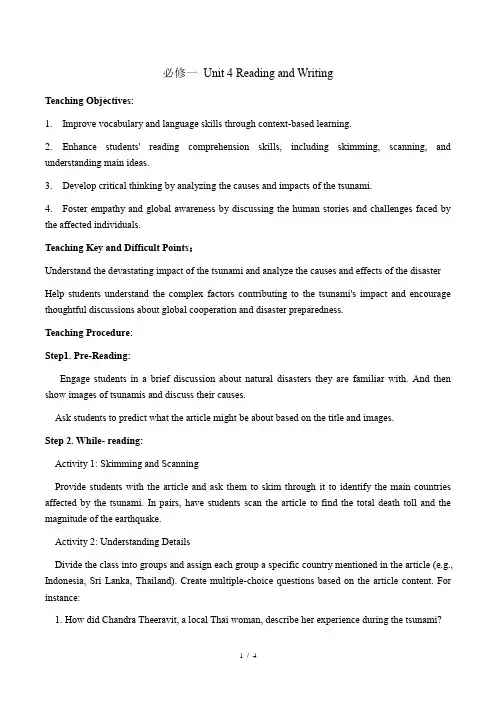
必修一Unit 4 Reading and WritingTeaching Objectives:1.Improve vocabulary and language skills through context-based learning.2.Enhance students' reading comprehension skills, including skimming, scanning, and understanding main ideas.3.Develop critical thinking by analyzing the causes and impacts of the tsunami.4.Foster empathy and global awareness by discussing the human stories and challenges faced by the affected individuals.Teaching Key and Difficult Points:Understand the devastating impact of the tsunami and analyze the causes and effects of the disasterHelp students understand the complex factors contributing to the tsunami's impact and encourage thoughtful discussions about global cooperation and disaster preparedness.Teaching Procedure:Step1. Pre-Reading:Engage students in a brief discussion about natural disasters they are familiar with. And then show images of tsunamis and discuss their causes.Ask students to predict what the article might be about based on the title and images.Step 2. While- reading:Activity 1: Skimming and ScanningProvide students with the article and ask them to skim through it to identify the main countries affected by the tsunami. In pairs, have students scan the article to find the total death toll and the magnitude of the earthquake.Activity 2: Understanding DetailsDivide the class into groups and assign each group a specific country mentioned in the article (e.g., Indonesia, Sri Lanka, Thailand). Create multiple-choice questions based on the article content. For instance:1. How did Chandra Theeravit, a local Thai woman, describe her experience during the tsunami?A. She was having breakfast with her family when they were trapped inside their home.B. She felt a strong earthquake while having breakfast.C. She witnessed large waves crashing into the coastlines.D. She had to leave her home and belongings to escape to safety.2. What challenges are expected in delivering foreign aid to the tsunami-hit countries?A. Lack of available suppliesB. Damaged roads and dangerous conditionsC. Inadequate funding for relief effortsD. Limited cooperation from affected governments3. What topic does the article suggest for further research and reflection?A. The economic impact of the tsunami on global marketsB. The historical occurrence of tsunamis in AsiaC. The importance of disaster preparedness and global cooperationD. The role of local communities in providing relief to disaster-stricken areasStep 3. Post-Reading:Activity 1: Reflection and DiscussionLead a class discussion on the emotional and physical challenges faced by the individuals mentioned in the article (e.g., Chandra Theeravit). Encourage students to reflect on their own reactions to the news and discuss how they would feel and respond if faced with a similar situation.Activity 2: Guidelines for Disaster Self RescueShow students disaster self-rescue videos, including earthquakes, floods, typhoons, etcSummarizing and WritingAsk students to write a brief summary of the article in their own words. Encourage them to express their thoughts on the importance of global cooperation during times of crisis.Possible answer:The article discusses a powerful earthquake-triggered tsunami that hit Asia,causing significant casualties and destruction. Over 6,500 lives were lost across countries like Indonesia, India, and Thailand. This catastrophe underscores the urgent need for global cooperation during crises. Collaborative efforts in disaster preparedness and early warnings can save lives. The tragedy highlights the interconnectedness of our world and the importance of united international action for effective response and recovery.Homework:Assign students to research and present a short report on a different natural disaster, emphasizing its causes, effects, and the response to it.范文:The Wenchuan Earthquake, also known as the Great Sichuan Earthquake, struck China on May 12, 2008. It was a devastating seismic event with a magnitude of 7.9 that caused widespread destruction. The earthquake's epicenter was in the Sichuan province, and its effects were felt across the region.The earthquake resulted from the collision of the Indian Plate with the Eurasian Plate, causing immense tectonic stress along the Longmenshan Fault. This stress accumulated over time until it was released in a powerful rupture, causing the ground to shake violently.The earthquake caused extensive damage, including the collapse of buildings, landslides, and the formation of cracks in the earth. Thousands of lives were lost, and many more were injured. Infrastructure, including roads and schools, was severely impacted.China launched a massive and swift response effort. Rescue teams were mobilized, and relief supplies were dispatched to the affected areas. The government also focused on rebuilding and retrofitting structures to withstand future earthquakes. The disaster prompted international aid and highlighted the need for disaster preparedness.In conclusion, the Wenchuan Earthquake was a tragic event caused by tectonic forces, resulting in significant destruction and loss of life. The response efforts demonstrated the importance of preparedness and cooperation in mitigating the impacts of natural disasters.。
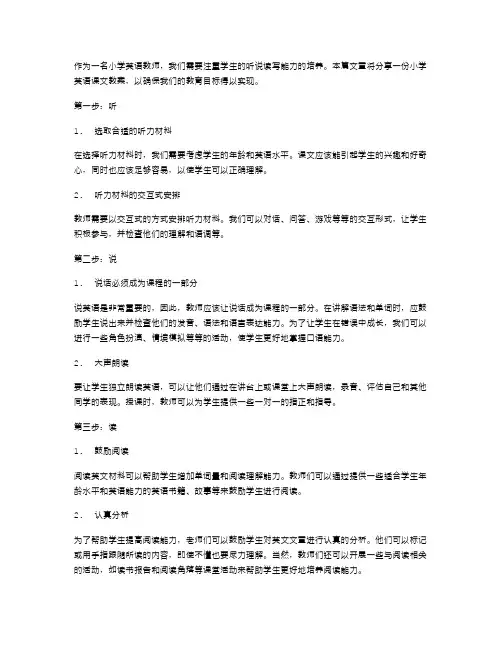
作为一名小学英语教师,我们需要注重学生的听说读写能力的培养。
本篇文章将分享一份小学英语课文教案,以确保我们的教育目标得以实现。
第一步:听1.选取合适的听力材料在选择听力材料时,我们需要考虑学生的年龄和英语水平。
课文应该能引起学生的兴趣和好奇心,同时也应该足够容易,以使学生可以正确理解。
2.听力材料的交互式安排教师需要以交互式的方式安排听力材料。
我们可以对话、问答、游戏等等的交互形式,让学生积极参与,并检查他们的理解和语调等。
第二步:说1.说话必须成为课程的一部分说英语是非常重要的,因此,教师应该让说话成为课程的一部分。
在讲解语法和单词时,应鼓励学生说出来并检查他们的发音、语法和语言表达能力。
为了让学生在错误中成长,我们可以进行一些角色扮演、情境模拟等等的活动,使学生更好地掌握口语能力。
2.大声朗读要让学生独立朗读英语,可以让他们通过在讲台上或课堂上大声朗读,录音、评估自己和其他同学的表现。
授课时,教师可以为学生提供一些一对一的指正和指导。
第三步:读1.鼓励阅读阅读英文材料可以帮助学生增加单词量和阅读理解能力。
教师们可以通过提供一些适合学生年龄水平和英语能力的英语书籍、故事等来鼓励学生进行阅读。
2.认真分析为了帮助学生提高阅读能力,老师们可以鼓励学生对英文文章进行认真的分析。
他们可以标记或用手指跟随所读的内容,即使不懂也要尽力理解。
当然,教师们还可以开展一些与阅读相关的活动,如读书报告和阅读角落等课堂活动来帮助学生更好地培养阅读能力。
第四步:写1.为写字分配时间教师们可以为学生分配一些写字任务,例如写作文、翻译句子、填写表格等。
对于初学者来说,应该提供一些简单而短小的写作任务,以逐渐提高他们的英文写作能力。
2.纠错并鼓励教师要耐心的纠正学生的错误,并鼓励他们继续努力。
我们可以提供更多的机会,让他们写更多的文章,翻译更多的句子,以便让学生快速提高其英文写作能力。
总体而言,以上提及的方法都是值得我们去尝试的。
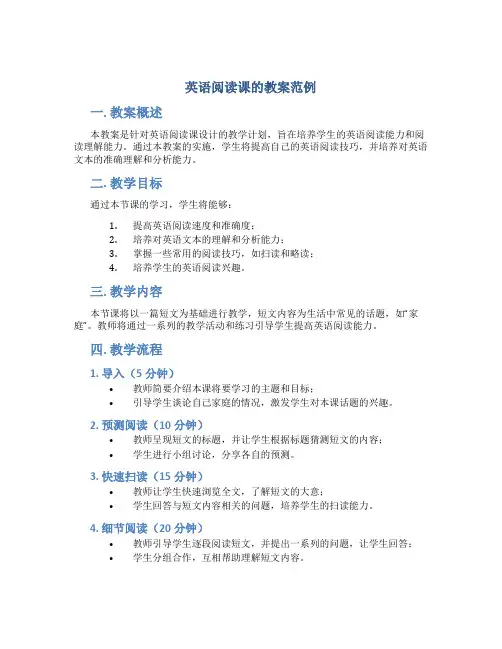
英语阅读课的教案范例一. 教案概述本教案是针对英语阅读课设计的教学计划,旨在培养学生的英语阅读能力和阅读理解能力。
通过本教案的实施,学生将提高自己的英语阅读技巧,并培养对英语文本的准确理解和分析能力。
二. 教学目标通过本节课的学习,学生将能够:1.提高英语阅读速度和准确度;2.培养对英语文本的理解和分析能力;3.掌握一些常用的阅读技巧,如扫读和略读;4.培养学生的英语阅读兴趣。
三. 教学内容本节课将以一篇短文为基础进行教学,短文内容为生活中常见的话题,如“家庭”。
教师将通过一系列的教学活动和练习引导学生提高英语阅读能力。
四. 教学流程1. 导入(5分钟)•教师简要介绍本课将要学习的主题和目标;•引导学生谈论自己家庭的情况,激发学生对本课话题的兴趣。
2. 预测阅读(10分钟)•教师呈现短文的标题,并让学生根据标题猜测短文的内容;•学生进行小组讨论,分享各自的预测。
3. 快速扫读(15分钟)•教师让学生快速浏览全文,了解短文的大意;•学生回答与短文内容相关的问题,培养学生的扫读能力。
4. 细节阅读(20分钟)•教师引导学生逐段阅读短文,并提出一系列的问题,让学生回答;•学生分组合作,互相帮助理解短文内容。
5. 理解与分析(15分钟)•教师引导学生对短文进行理解和分析,提出一些开放性问题供学生思考和讨论;•学生进行小组讨论,分享自己的观点和答案。
6. 小结与拓展(10分钟)•教师对课堂内容进行总结,强调学生在本节课中学到的重点知识和技巧;•教师布置相关阅读作业,加深学生对英语阅读的训练和应用。
五. 教学方法本节课采用多种教学方法,如导入讨论、小组合作、问题引导等方法,旨在激发学生的英语阅读兴趣,提高他们的阅读能力。
六. 教学评估本节课的教学评估主要通过以下几种方式进行:•学生在课堂上的积极参与程度;•学生在小组讨论和问题回答中的表现;•学生对文章内容的准确理解和分析能力。
七. 教学资源•短文《家庭》(准备足够的复印件供学生使用);•问题练习;•小组讨论指南。
英语读写综合教案初中一、教学目标:1. 知识目标:(1)学生能够掌握一定的英语词汇和语法知识。
(2)学生能够理解阅读材料的基本内容,具备一定的阅读理解能力。
(3)学生能够运用所学知识进行简单的英语写作。
2. 能力目标:(1)学生能够具备一定的英语听、说、读、写能力。
(2)学生能够通过阅读获取信息,提高阅读理解能力。
(3)学生能够运用英语进行日常交流和表达。
3. 情感目标:(1)激发学生学习英语的兴趣,培养学生的学习积极性。
(2)培养学生团结协作、积极参与的精神风貌。
二、教学内容:1. 词汇:本节课将引入新的词汇,如:actor, actress, movie, interesting等。
2. 语法:一般现在时态的肯定句和否定句。
3. 阅读材料:一篇关于电影的文章。
4. 写作任务:以“我最喜欢的电影”为主题,写一篇短文。
三、教学过程:1. 热身活动(5分钟)(1)教师与学生进行简单的英语对话,检查学生的英语水平。
(2)学生进行小组活动,用英语介绍自己的兴趣爱好。
2. 词汇学习(10分钟)(1)教师展示新词汇,引导学生跟读并记忆。
(2)学生进行词汇练习,巩固所学词汇。
3. 阅读理解(15分钟)(1)教师发放阅读材料,学生自主阅读。
(2)教师提问,检查学生的阅读理解能力。
(3)学生进行小组讨论,分享阅读心得。
4. 写作指导(10分钟)(1)教师引导学生思考写作主题,指导学生进行写作。
(2)学生进行写作练习,教师巡回指导。
5. 展示与评价(10分钟)(1)学生展示自己的写作成果,进行自评和互评。
(2)教师对学生的写作进行评价,给予鼓励和建议。
6. 总结与作业(5分钟)(1)教师对本节课的内容进行总结,强调重点。
(2)布置作业:复习本节课的词汇和语法,预习下一节课的内容。
四、教学策略:1. 任务型教学法:通过小组活动和写作任务,激发学生的学习兴趣,培养学生的合作精神。
2. 交际式教学法:教师与学生进行英语对话,提高学生的听说能力。
教学主题:英语读写课教学设计教学目标:1. 提高学生的英语听力和阅读能力。
2. 帮助学生掌握一些阅读技巧和写作技巧。
3. 培养学生的英语思维和表达能力。
教学内容:1. 阅读理解:选择一篇适合学生水平的英语文章,教授学生阅读文章的技巧和策略,如查找关键词、推测词义等。
然后组织学生进行相关的阅读理解练习,包括回答问题、填空、选择题等。
2. 阅读扩展:选择一些与文章主题相关的扩展阅读材料,如新闻报道、故事、科普文章等。
让学生进行阅读,并组织小组讨论和分享他们的理解和观点。
3. 写作练习:根据阅读材料或主题,给学生提供一些写作任务,如写一篇读后感、写一篇文章概要、写一篇问题解答等。
引导学生运用已学的阅读技巧和写作技巧来完成这些写作练习。
教学步骤:Step 1: 导入通过引入一个与主题相关的问题或图片来激发学生的兴趣,并预告本节课将进行的学习内容。
Step 2: 阅读理解选择一篇适合学生水平的英语文章,讲解一些阅读技巧和策略,如提问关键词、预测文章内容等。
然后让学生阅读文章,并进行相关的阅读理解练习,如回答问题、填空等。
Step 3: 阅读扩展提供一些与文章主题相关的扩展阅读材料,让学生进行阅读,并组织小组讨论和分享他们的理解和观点。
教师可以提出一些导向性的问题,引导学生深入思考和交流。
Step 4: 写作练习根据阅读材料或主题,给学生提供一些写作任务,如写一篇读后感、写一篇文章概要、写一篇问题解答等。
引导学生运用已学的阅读技巧和写作技巧来完成这些写作练习。
教师可以提供一些写作模板和指导,让学生有条理地展开写作。
Step 5: 总结和评价回顾本节课的学习内容,引导学生总结所学的阅读技巧和写作技巧,并给予积极的评价和鼓励。
Step 6: 作业布置布置相应的作业,如练习题、写作任务等,以巩固学生的学习成果。
教学资源:1. 与主题相关的英语文章和阅读材料。
2. 阅读理解练习题和写作练习题。
3. 各种学习资料和工具,如黑板、投影仪等。
逆向设计理念下高中英语读写教学设计探究摘要:为了解决教师在高中英语教材读写板块实际教学中存在的问题,提高读写教学的效率,教师需要改变并使用新的教学设计理念。
文章就Understanding by Design理念,亦称“逆向设计”(Backward Design)理念进行了深入研究,以一堂读写课为例,探析在高中英语读写课中如何从确定预期结果、预设合适的评估证据与设计学习体验教学活动三个阶段进行逆向教学设计。
文章的研究成果可以使各个教学目标有机融合,突出学生的主体地位,有效提高读写教学的效率,提升学生的读写能力。
关键词:逆向设计;高中英语;读写教学一、逆向设计理论概述(一)逆向设计的定义与特点美国教育学家Grant Wiggins和Jay McTighe提出了Understanding by Design理念,即“追求理解的教学设计”,也称“逆向设计”(Backward Design)。
逆向设计(Backward Design)是一种以终为始的教学设计理论,主要通过设置预期目标、收集达成目标的证据、围绕目标安排教学活动三个方面促进学生的深度学习。
这种教学设计有别于传统教学设计,它以学生的学习目标为教学出发点,思考为了实现学习目标,学生需要做什么,是以结果为导向的教学模式。
它能有效整合教学目标、评价标准以及教学活动,体现了教学评一体化,弥补了传统教学设计的不足。
教师采用逆向教学法设计读写课堂,从写作目标的确定和评价设计出发,依据学情制订学习任务和活动,可以做到有的放矢、不偏离方向,极大地提高英语读写教学的效率。
(二)逆向设计的步骤Grant Wiggins和Jay McTighe在《追求理解的教学设计(第二版)》中认为,逆向设计分为3个阶段:确定预期的结果—确定合适的评估证据—设计学习体验和教学。
逆向设计是“以终为始”,即从预期的结果开始。
它是先根据教学内容和学生的实际需求确定预期教学目标,再设置教学评价,了解学生是否已经达到预期的理解和掌握程度;接着使用最恰当的方式开展学习体验和教学活动。
高中英语读写整合教学设计一、教学任务及对象1、教学任务本教学任务是基于高中英语读写整合的课程设计,旨在提高学生的英语阅读理解能力、写作技巧及语言运用综合能力。
通过精选阅读材料,结合写作训练,使学生能够掌握文章结构、理解文本深层含义,同时培养他们的批判性思维和创造性表达能力。
此外,课程还将注重提高学生听说能力的协调发展,以实现英语综合运用能力的全面提升。
2、教学对象教学对象为高中一年级或二年级的学生,他们已经具备一定的英语基础知识,能够理解和使用简单的英语句型,但对于复杂的阅读材料和高级写作技巧仍需进一步指导。
学生群体中,英语水平参差不齐,因此教学设计需兼顾不同层次学生的需求,激发他们的学习兴趣,提高英语学习的积极性。
此外,考虑到学生正处于青春期,教学过程中应注重培养他们的自主学习能力和团队合作精神,帮助他们建立正确的价值观和人生观。
二、教学目标1、知识与技能(1)阅读理解:通过本课程的学习,使学生能够理解并分析高中英语教材及课外阅读材料中的复杂句子结构和文章组织形式,掌握文章主旨大意,提高阅读速度和理解能力。
(2)写作技巧:培养学生运用不同写作技巧,如叙述、描写、议论等,进行创意写作和观点阐述,使文章结构清晰,内容丰富,逻辑性强。
(3)语言运用:加强学生对词汇、语法和句型的掌握,提高口语表达和听力理解能力,使学生在实际语境中能准确、流利地使用英语进行沟通。
2、过程与方法(1)自主学习:鼓励学生课前预习、课后复习,培养良好的学习习惯,提高自主学习能力。
(2)合作学习:通过小组讨论、互动交流等形式,使学生学会倾听他人意见,培养团队协作精神。
(3)探究学习:引导学生主动发现、分析和解决问题,培养批判性思维和创新意识。
3、情感,态度与价值观(1)激发兴趣:通过生动有趣的教学活动,激发学生学习英语的兴趣,帮助他们树立自信心,勇于挑战自我。
(2)培养积极态度:引导学生正确面对英语学习中的困难和挫折,保持积极向上的心态,持之以恒地学习。
必修第一册Unit 2 Travelling Around教学设计Period 4 Reading for WritingTeaching material: Write to a friend about a travel planTeaching objectives: In this lesson, the students will1. read an email telling one’s travel plan and master its structure2. master the word and expressions to express feelings3. write an email to a friend to share their travel plans4. get to know better about Terracotta Army and be proud of ChinaDifficult and focal point: Guide the students to write a well-organized email to state their travel plan, using the expressions to express their feelingsTeaching aids: PowerPoint, blackboardTeaching approaches: PWP Teaching MethodTeaching procedures:Step 1 Lead inActivity 1 Free talkHave you ever travelled to Xi’an?What attractions impressed you most?How much do you know about the Terracotta Army?Activity 2 Read the travel brochurePlease read the page about the Terracotta Army from a travel brochure and tell us what amazes you most.I was amazed by...I can’t believe that......amazes me most.It’s unbelievable to me that...Do you want to visit the Terracotta Army? Richard is visiting it with his parents during the October holiday and he shared his travel plan with his friend Xiao Li.Step 2 Pre-writingActivity 1 Read for structure1. Glance through the email page and pay attention to its structure.2. Read Richard’s email and find out what aspects of a travel plan are covered in his email.3. Read the email again and fill in the table below.1. Read the email again and circle present continuous tense.2. Read the email again and underline the words and phrases that Richard used to express emotion.Can you think of other ways to express emotion?1)I have been longing for ...2)It’s my dream destination.3)I’ve always wanted to visit ...4)I’m dying to see ...5)How exciting it is to ...Step 3 While-writingActivity1 BrainstormingWork in pairs and have a discussion.Pretend you are Xiao Li and you are replying an email to Richard to share your travel plan for the coming holiday. When we share our travel plans with our friends, what do we usually talk about?destination, main purpose for the trip, reasons for the trip, transport, accommodation, length of thetrip, activity, other details (passport, visa, weather, credit card, shopping ...)1. Where are you traveling?2. Why are you going there?3. How are you going there and how are you getting around?4. How are you feeling for the coming holiday?Activity 2 DraftingPick your destination and write your travel plan based on the structure of Richard’s email and the useful expressions.Step 4 Post-writingActivity 1 Evaluation1. Exchange your drafts and assess each other’s work according to the checklist(1) Is there a clear purpose for the trip?(2) Does each paragraph have a clear main idea?(3) Does the writer use the present continuous tense for future plans?(4) Does the writer use commas, stops and question marks correctly?(5) Are all the words spelt correctly?(6) Are all the proper nouns capitalised?Activity 2 PolishingGet your draft back and revise it according to your partner’s comments.Activity 3 Present your email to the class.Sample WritingTo:***************.cnSubject: My travel plan to LondonDear Richard,My time in England is going wonderfully! My new school is amazing, and all the teachers and classmates are so friendly. Over the Christmas holiday, my parents and I are going up to London to see the Tower of London. This is the old castle that the king used to live in. Later, it was used as a prison for people who angered the king. It’s also where the marvellous Crown Jewels are located. I just can’t wait to see it. It has such an incredible history and there are so many amazing stories connected with it.We’re also planning on seeing Big Ben, Westminster Abbey, and the Millennium Bridge while we are there, and of course we’re going to ride on the London Eye! I think my mother is mostly interested in the shopping, however, so we will also stop by Regent Street.We plan on taking a train up, which should only take an hour and a half. Since we are staying for a week, we plan on just stretching our legs a little after we arrive and then hitting the sights the next day.Well, I guess that’s about it for now. I’ll buy you a souvenir from the Tower shop. Talk later!Your friend,Xiao LiStep 5 Language points1. Find and underline the following phrases on page 18.2. Underline the following sentence and analyze its structure.Step 6 Homework假如你是李华,你打算和家人一起去度假。
一堂英语读写课的教学设计
The camel that I rode had a bad temper.
一、教学目标:通过阅读,了解澳大利亚的风土人情,增加对外国文化的了解;同时感受作者的写作思路和遣词造句的技能,从而对自己接下来的仿写有所启示,在实践中不断地提高自己的阅读能力和写作水
二、教学程序:
1. 导入
(1)要求学生回答以下2个问题:
Where have you been? What do you think of it?
Have you ever been to Australia? What do you know about it?
(2)出示几幅有关澳大利亚的图片并要求学生谈论图片的内容。
(3)向学生介绍这节课的教学内容:
Today we are going to read a letter from Tony, he will tell us something about Australia. Are you interested in it?
2. 泛读
要求学生快速地阅读课文,并回答以下2个问题:
Where is Tony now?
What does he think of his trip?
3. 精读
要求学生仔细地阅读课文,并完成以下练习:
(1)How many paragraphs are there in the letter? What’s the main idea of each paragraph?(2)Can you finish the following form?
Write notes about these.
Uluru:
The Aborigines:
Australian lifestyle:
Weather:
Language:
Events during the trip:
(3)Check(√)the true statements.
①The Aboriginal name for Uluru is Ayers Rock. ( )
② The rock is always purple. ( )
③ Stories about the creation of the world are an important part of Aboriginal culture. ( )
④ Water sports are the most popular in Australia. ( )
⑤When it’s winter in Australia, it’s summer in China. ( )
⑥The special expressions which Australians use are still in English.( )
⑦Tony didn’t find riding a camel very easy. ( )
4. 复述课文
要求学生对课文内容进行复述,并给出下列短语:On the first day..., The Australian family life..., The weather here..., They speak..., The next day..., Finally...
(1)老师先给学生做示范,用较慢的语速进行复述,以便学生能抓住Key words。
(2)叫2个学生进行复述。
(3)全班同学在老师的引导下一起复述。
5. 小结课文
Now we know a lot about Australia, its people, its lifestyle, its food and its language, it is really a unique country. Do you think so?
6. 仿写
要求学生仿照这封信的格式,写一封信给他们的朋友,告诉他/ 她你曾经到访过的某个地方,内容包括the people, their lifestyle, their food, their language and the events during the trip。
(1)要求学生先在脑海中构思一遍,想出一个大致的框架。
(2)动笔,要尽可能地运用自己所熟悉的短语和句型,越简单越好。
(3)写完后和同学交换修改。
7. 点评
抽查2个学生的作文,投影在屏幕上展示给学生看,并与学生一起进行修改,最后进行点评。
8. 课后作业布置
要求学生把堂上作文带回家进行修改,第二天上交。
. .。